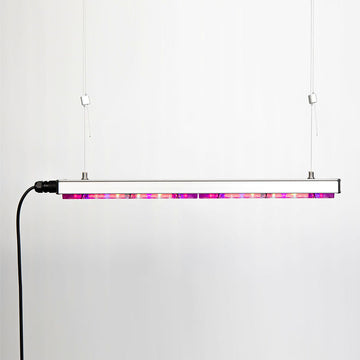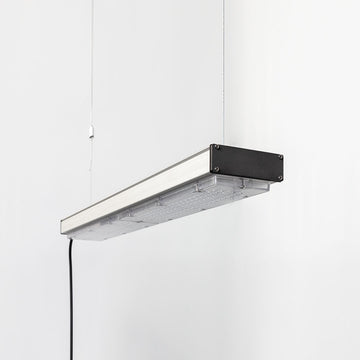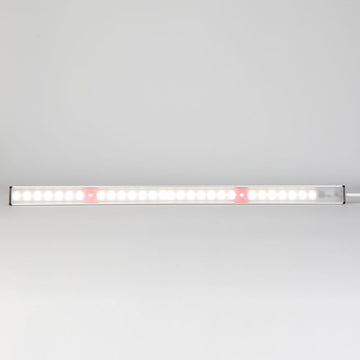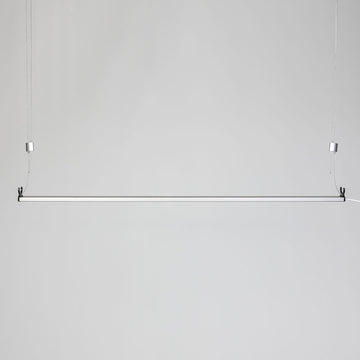Lighting knowledge
Understanding what plants really need
Lighting knowledge
Light is more than just brightness. It is energy, information, and a crucial engine for life on our planet—especially for plants.
Indoor growers quickly face the question: What constitutes good plant light? And why isn't a simple "bright lamp" enough?
In our Light Knowledge section, we give you easy-to-understand insights into the world of light spectra, photon fluxes, and plant physiology – so that you don't just illuminate, but really understand how plants react to light .
Because only those who know the basics can get the maximum out of their setup – regardless of whether it is during cultivation, growth or flowering.
Immerse yourself in Growality knowledge – and show your plants in the best light.

What is light actually?
Light is a form of electromagnetic radiation that moves through space in waves – at the same time it consists of tiny packets of energy called photons .
A small part of this spectrum, the visible light between 400 and 700 nanometers , is not only perceptible to the human eye, but is also exactly the range that plants can use for photosynthesis .
These photosynthetically active photons (PAR) provide the energy plants need to grow, flower and bear fruit.
What does "nm" mean in light specifications?
"nm" stands for nanometer and describes the wavelength of light. Short wavelengths (e.g., blue light) have a lot of energy, while longer wavelengths (e.g., red light) are gentler but equally important for plants.
What is PAR, PPF, PPFD & PPE?
PAR : Photosynthetically Active Radiation – the range from 400–700 nm that plants use for photosynthesis.
PPF : Photon flux in μmol/s – how many usable photons the lamp emits in total.
PPFD : Photon density in μmol/m²/s – how many of these photons actually reach the plant.
PPE : Efficiency in μmol/J – how much usable light is produced per watt-hour consumed.
What is a light spectrum?
The light spectrum indicates which wavelengths an LED emits. Full-spectrum lights combine the entire PAR spectrum with ideal peaks for growth and flowering – just like our VegaSpectrum .
What is the difference between white light and special grow light?
White light is pleasant for the eye – but not suited to plants .
Grow lights specifically emit the photons that plants really need – without energy loss through useless wavelengths.
What is the difference between lux, lumen, PAR and PPFD?
Lux/Lumen : Light for the eye
PPFD/PAR : Light for plants
--> Only PPFD counts for your grow result.

Why are our lights so efficient?
Because we rely on high-end LEDs with PPE values of up to 3.2 μmol/J – that means more usable light per watt of electricity .
Why is dimming useful?
- Saving energy in the germination and veggie phase
- Avoiding light stress
- Fine adjustment to varieties & tent size
With Smart Control you can conveniently control our lights via app.
How much power does an LED grow light really consume?
Example calculation:
A VEGA Pro One with 200 W consumes 2.4 kWh/day when running for 12 hours.
Depending on the electricity tariff (~0.30 €/kWh) this means:
👉 ~72 cents per day , or ~22 €/month – at 100% performance.
This is what a realistic power consumption over a complete 3-phase grow (approx. 12 weeks) looks like:
1. Germination (2 weeks / 14 days)
- Light duration: 18 hours / day
- Dimmed power: approx. 30% = 60 W
- Daily consumption: 1.08 kWh
- Total costs:
1.08 kWh × 14 days × €0.30 = €4.54
2. Vegetative phase (4 weeks / 28 days)
- Light duration: 18 hours / day
- Dimmed power: approx. 70% = 140 W
- Daily consumption: 2.52 kWh
- Total costs:
2.52 kWh × 28 days × €0.30 = €21.17
3. Flowering phase (6 weeks / 42 days)
- Light duration: 12 hours / day
- Full power: 100% = 200 W
- Daily consumption: 2.4 kWh
- Total costs:
2.4 kWh × 42 days × €0.30 = €30.24
Total costs for a complete grow cycle (12 weeks):
A complete grow cycle with the Vega Pro One costs an average of around €56 in electricity – with optimal light and full control.
That’s less than €0.70 per day – for professional service from germination to harvest.
What does the lifespan of LEDs mean?
Our LEDs have a service life of over 100,000 hours (L80 at 25 °C) – that corresponds to 11.4 years of continuous operation with stable light output .
How important is heat dissipation?
Extreme! Good cooling means:
- less power loss
- more efficiency
- longer service life
Our lights use anodized aluminum and an external power supply – silent and maintenance-free.
How does the position of the lamp relate to the result?
The distance to the plant directly influences the light intensity (PPFD).
Ideal: 20–50 cm distance – depending on phase & power.
With our automatic rope system you can adjust the height in no time.
Growality know-how
What makes Growality lights special?
→ Highest efficiency (up to 3.2 μmol/J)
→ Optimized spectrum for growth & flowering
→ Plug & Play + Smart Control
→ Durable, quiet & sustainable
→ Developed and produced in Germany – by growers for growers
Can I grow anything with grow lights?
Absolutely. Our lights are suitable for:
→ Herbs, microgreens, vegetables
→ Cannabis & Hemp
→ Exotic houseplants, bonsai, succulents
→ Orchids, salads and much more


Vega Pro One - Grow Light


Aurora Basic Sidelights - Grow Light


Vega Pro One - Grow Light




